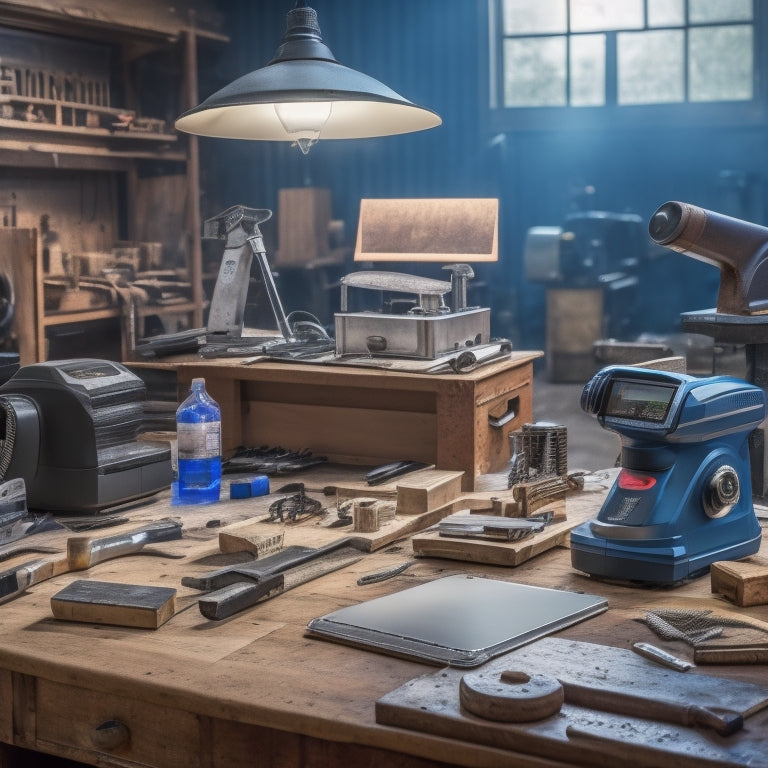
Top Rated Scanning Devices for Renovation Pros
Share
As a renovation professional, you require high-quality scanning devices to accurately detect hidden structures, identify materials, and pinpoint obstacles. DeWalt, Bosch, and Zircon offer advanced wall scanning tools with deep scanning modes, high-resolution imaging, and user-friendly interfaces. For block wall builders, these devices are essential for safe drilling and structural integrity. Wireless options enhance mobility, while top-rated radar detectors provide pinpoint accuracy. Thermal imaging scanners and specialized tools for electricians and drywall applications are also available. By choosing the right device, you'll make informed decisions, reduce downtime, and drive productivity - and that's just the beginning of what you'll discover.
Key Takeaways
• Top-rated scanning devices for renovation pros include DeWalt DW0714, Bosch GMS120, and Zircon StudSensor e50, offering advanced scanning technology.
• Accurate material identification is crucial for ensuring project adherence to codes, utilizing radar, infrared, and acoustic sensors for enhanced accuracy.
• Wireless scanning devices like those from DeWalt and Bosch offer enhanced mobility and convenience on job sites with Bluetooth connectivity.
• Thermal imaging scanners like FLIR GF320, Fluke Ti400, and Testo 868 aid in identifying costly repairs and inefficiencies, improving energy efficiency and safety.
• High-end scanning devices from Fluke, Amprobe, and Greenlee provide advanced sensors, higher-resolution displays, and Wi-Fi connectivity for efficient troubleshooting.
Top Wall Scanning Tools Compared
When selecting the right tool for your renovation project, you'll want to contemplate the top wall scanning devices on the market, including the DeWalt DW0714, Bosch GMS120, and Zircon StudSensor e50. Each of these devices offers unique features and functionalities that cater to specific needs and preferences.
These devices boast advanced scanning technology, allowing you to quickly and accurately detect studs, wires, and other obstacles behind walls.
The DeWalt DW0714, for instance, features a deep scanning mode that can detect objects up to 3.75 inches deep, making it ideal for thicker walls.
The Bosch GMS120, on the other hand, offers a high-resolution 2.4-inch color display, providing you with clear and detailed images of what's behind the wall.
Meanwhile, the Zircon StudSensor e50 is praised for its user-friendly features, including a simple and intuitive interface that makes it easy to navigate.
Best for Block Wall Builders
When you're working with block walls, you need a scanning device that can accurately detect wall thickness and identify materials hidden behind the surface.
You'll want a tool that can pinpoint the location of rebar, conduit, and other obstructions, ensuring your drilling and cutting efforts are precise and safe.
Wall Thickness Detection
How accurately can you detect the thickness of a block wall without tearing it apart, especially when precise measurements are vital for renovation projects?
With advanced scanning devices, you can now make precise measurements without damaging the wall. For block wall builders, wall thickness detection is vital to determine the correct fastening systems, guarantee structural integrity, and prevent costly mistakes.
When it comes to detecting wall thickness, stud wall detection and concrete scanning are vital features to look for in a scanning device. A high-quality scanner can accurately detect the thickness of a block wall, including the location and depth of rebar, pipes, and other embedded objects. This information enables you to plan your renovation project with confidence, guaranteeing that your drilling and cutting operations are precise and safe.
With the right scanning device, you can quickly and easily detect wall thickness, reducing the risk of errors and increasing your productivity. Look for devices that offer high-resolution imaging, advanced signal processing, and intuitive software to guarantee accurate and reliable results.
Accurate Material Identification
You need to identify the materials behind the wall to confirm that your renovation project stays on track, and advanced scanning devices can help you do just that.
As a block wall builder, you understand the importance of accurate material identification to maintain structural integrity and prevent costly rework.
Advanced scanning devices employ cutting-edge material detection techniques, such as radar, infrared, and acoustic sensors, to detect and analyze the properties of materials behind the wall.
Scanning technology advancements have notably improved the accuracy and speed of material identification, allowing you to quickly and confidently identify materials like concrete, wood, or metal.
With this information, you can make informed decisions about demolition, repair, or installation, confirming that your project meets building codes and regulations.
Wireless Scanning Device Options
By leveraging wireless connectivity, renovation professionals can now access a range of scanning devices that offer enhanced mobility and convenience on the job site.
With wireless scanning device options, you can move freely around the site without being tethered to a computer or other equipment. This increased flexibility allows you to focus on the task at hand, rather than worrying about cables or connections.
When it comes to wireless scanning devices, Bluetooth connectivity is a key feature to look for. This technology enables seamless data transfer between the scanner and your smartphone or tablet, ensuring that you can access and analyze scan data in real-time.
Furthermore, top-rated wireless scanning devices boast exceptional scanning accuracy, even in challenging environments. This means that you can trust the data you're collecting and make informed decisions about your renovation project.
Top Rated Radar Detectors
Radar detectors, which employ radio frequency signals to detect and track objects, have become essential tools for renovation professionals seeking to identify hidden structures, pipes, and conduits behind walls, ceilings, and floors. You need a reliable radar detector to avoid costly mistakes and guarantee a successful renovation project. When choosing a radar detector, consider the best radar features that meet your specific needs.
| Radar Detector Model | Radar Accuracy Comparison |
|---|---|
| DeWalt Radar Detector | ±1 mm accuracy at 10 cm depth |
| Bosch Radar Detector | ±2 mm accuracy at 20 cm depth |
| Milwaukee Radar Detector | ±0.5 mm accuracy at 5 cm depth |
As you can see from the table, each radar detector model has its own strengths and weaknesses when it comes to radar accuracy. The DeWalt Radar Detector excels at detecting objects at shallower depths, while the Milwaukee Radar Detector boasts superior accuracy at closer ranges. The Bosch Radar Detector offers a good balance between depth and accuracy. By understanding the capabilities of each radar detector, you can make an informed decision and choose the best tool for your renovation project.
Scanner Devices for Drywall
Scanning devices specifically designed for drywall detection offer a non-invasive and efficient way to locate studs, wires, and other hidden objects behind gypsum-based walls. As a renovation pro, you know how vital it's to identify these hidden elements before drilling or cutting into the drywall. You can't afford to risk damaging pipes, wires, or other essential infrastructure.
Drywall scanning devices take the guesswork out of the equation, providing you with accurate and reliable data to inform your installation decisions.
When selecting a drywall scanner, look for devices with high-frequency sensors that can penetrate thick drywall and detect objects up to 3 inches deep. Some top-rated models come with advanced features like LED lights, audio alerts, and adjustable sensitivity settings to help you zero in on your target.
For best results, follow these installation tips: calibrate your scanner before each use, scan slowly and methodically, and avoid scanning over metal studs or other conductive materials that can interfere with the signal.
Thermal Imaging Scanners Reviewed
Five top-rated thermal imaging scanners are put to the test in this review, helping you determine which device best suits your needs for detecting temperature anomalies and energy losses behind walls, ceilings, and floors. As a renovation pro, you know the importance of identifying issues that can lead to costly repairs or energy inefficiencies. Thermal imaging scanners offer a non-invasive way to detect temperature differences, allowing you to pinpoint areas of concern.
Here's a comparison of our top picks:
| Scanner Model | Thermal Imaging Benefits | Thermal Imaging Applications |
|---|---|---|
| FLIR GF320 | High-resolution images, accurate temperature readings | Energy audits, predictive maintenance, building inspections |
| Fluke Ti400 | Rugged design, advanced analytics software | HVAC, electrical, and mechanical inspections |
| Testo 868 | High-speed thermal imaging, precise temperature measurement | Building envelope inspections, moisture detection |
When choosing a thermal imaging scanner, consider the level of accuracy and detail you need, as well as the specific applications you'll be using it for. By leveraging thermal imaging benefits, you can improve energy efficiency, reduce repair costs, and enhance your overall renovation process.
Popular Scanning Tools for Electricians
As an electrician, you rely on specialized tools to detect and diagnose electrical issues. Incorporating advanced scanning devices into your workflow can greatly enhance your troubleshooting capabilities.
With the right scanning tools, you can quickly identify electrical faults, reduce downtime, and improve overall efficiency.
Here are some popular scanning tools that can take your electrical work to the next level:
-
Fluke Ti300+ Infrared Camera: A high-resolution thermal imaging camera with wireless technology for seamless image transfer and reporting.
-
Amprobe AT-6020 Advanced Wire Tracer: A non-invasive wire tracing device that uses advanced signal processing to detect and identify wires behind walls and in ceilings.
-
Greenlee GT-12-HD High-Definition Thermal Imager: A rugged and durable thermal imager with a user-friendly interface and advanced analytics software.
- Extech EX540 Industrial-Grade Multimeter: A high-accuracy multimeter with advanced scanning capabilities, including wireless connectivity for data transfer and analysis.
These scanning tools are designed to provide you with accurate and reliable data, helping you to diagnose electrical issues quickly and efficiently.
High-End Scanning Devices Worth
Investing in high-end scanning devices can greatly elevate your electrical troubleshooting capabilities, especially when working on complex or high-stakes projects that demand pinpoint accuracy and reliability. You'll appreciate the advanced features and precision these devices offer, making it easier to identify issues and solve problems efficiently.
High-end scanning devices are equipped with advanced sensors, higher-resolution displays, and more powerful processing capabilities, allowing you to scan larger areas and detect even the smallest anomalies.
When choosing a high-end scanning device, look for models with advanced features such as thermal imaging, Wi-Fi connectivity, and advanced data analysis software. User reviews can also provide valuable insights into a device's performance and reliability.
Top-rated high-end scanning devices often receive praise for their ease of use, durability, and accuracy. By investing in a high-end scanning device, you'll be able to take your electrical troubleshooting skills to the next level, tackling even the most complex projects with confidence.
With the right device, you'll be able to identify issues quickly, reduce downtime, and increase productivity, making it a worthwhile investment for any serious renovation pro.
Frequently Asked Questions
Can Scanning Devices Detect Objects Behind Multiple Layers of Drywall?
When you're working on a renovation project, you need to know if scanning devices can detect objects behind multiple layers of drywall.
The answer is, it depends on the device's frequency and power. High-frequency scanners (above 1 GHz) can penetrate a single layer of drywall, but may struggle with multiple layers.
You'll need a more powerful scanner, like a pulse radar or GPR device, to detect objects through multiple drywall layers.
Are Thermal Imaging Scanners Worth the High Cost for Small Projects?
Are you willing to break the bank for a thermal imaging scanner on your small project? It's an essential question.
When considering the cost, you must weigh the benefits against the expense. Conduct a thorough cost-benefit analysis, factoring in project size considerations.
If the scanner's precision and time-saving capabilities outweigh the high cost, then it's worth the investment.
However, for smaller projects, alternative options might be more feasible, providing similar results at a lower price point.
Do Wireless Scanning Devices Require Frequent Battery Replacements?
When you opt for wireless scanning devices, you'll likely wonder about battery life.
The good news is that most devices boast impressive battery life, often lasting several hours on a single charge.
Thanks to advancements in wireless technology, you can expect efficient power management.
However, frequent use may still require occasional battery replacements.
You'll need to weigh this against the convenience of wireless scanning, but many pros find it's well worth it.
Can Scanning Tools Detect Water Damage or Leaks Behind Walls?
Will you be able to uncover the hidden truth behind those walls? The answer is yes!
Advanced scanning tools are designed to detect water damage or leaks behind walls with precision. Equipped with cutting-edge water leak detection and wall moisture assessment capabilities, these devices can identify even the slightest signs of moisture intrusion.
You'll be able to pinpoint the source of the issue, ensuring a swift and effective repair.
Are Radar Detectors Safe to Use Near Sensitive Electronic Equipment?
When you're working with radar detectors near sensitive electronic equipment, you're right to wonder about electronic safety.
Radar detectors can emit electromagnetic radiation, which can cause radar interference. However, most modern detectors are designed to minimize interference, and you can take precautions to guarantee safe use.
Keep detectors at least 3 feet away from sensitive equipment, and use shielding or filters if necessary. By taking these steps, you can guarantee electronic safety and accurate readings.
Conclusion
You've weighed your options and explored the top-rated scanning devices for renovation pros. As you finalize your decision, consider this: according to a study, 80% of renovation projects experience delays due to hidden structural issues.
Investing in a high-quality scanning device can greatly reduce this risk. By choosing the right tool for your specific needs, you'll save time, money, and headaches in the long run.
Make an informed decision and get back to building with confidence.
Related Posts
-

Top Tools for DIY Home Renovation Plastering Success
To achieve DIY home renovation plastering success, you'll need a range of essential tools. Start with hand tools like...
-

Why Inspect Stucco Repair Equipment Before Renovation
When starting a stucco repair renovation, you need to inspect your equipment to prevent accidents, save time and mone...
-

3 Best DIY Home Renovation Timelines for Success
As you tackle your DIY home renovation project, create a solid timeline by breaking it down into three phases. First,...


